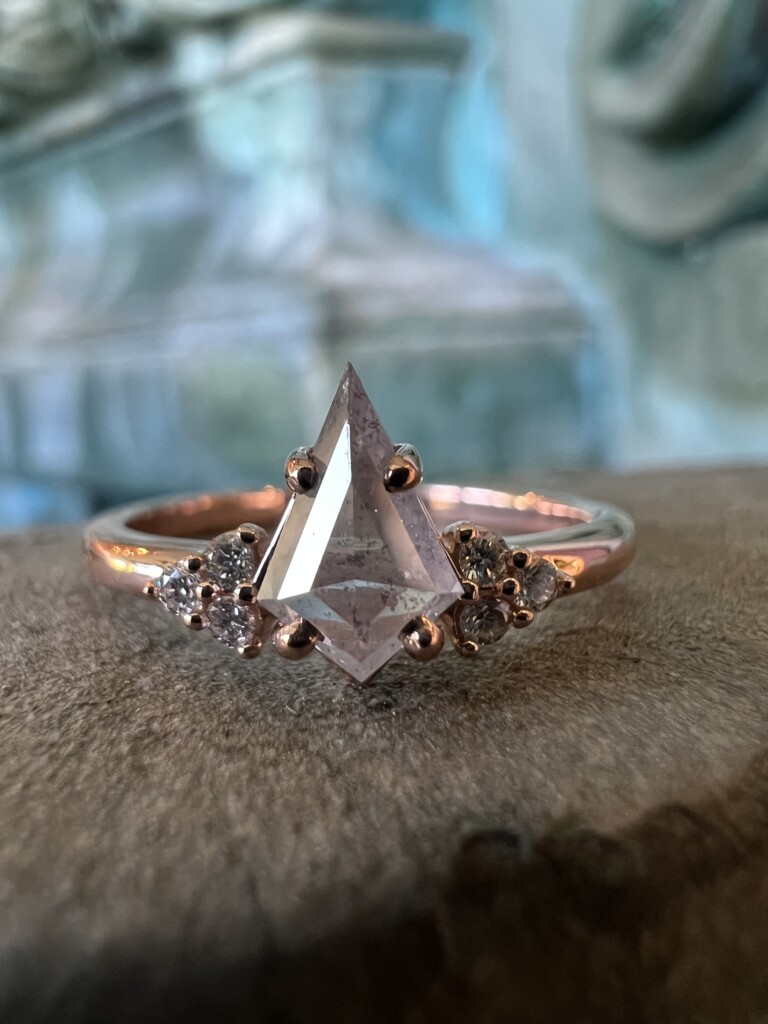Diamonds have long served as the ruler of the engagement ring. However, as newlyweds are seeking more affordable, unique, and customizable options, alternative stones have seen an increase in popularity. (585) talked with Ashley Harman, a representative from Forsythe Jewelers in Pittsford, to get some insight into alternative stones and the many available options.
Why do you think more people are using stones other than natural diamonds?
Many younger couples are budget conscious and prefer to invest their money into a home, student loans, emergency funds, etc. and less so into their engagement ring. We’re also seeing an uptick in larger-sized center stones, which means more traditional diamonds would bring them far over their budget.
On the flip side, couples finding themselves in another marriage later in life have already done a traditional ring and want their new engagement ring to reflect their current relationship and set it apart from their first marriage.
I also think social media has also given couples access to a slew of options that weren’t previously on anyone’s radar. I think seeing celebrities and influencers branching out into the alternative gemstone world is encouraging couples to think outside the box. Marketing absolutely influences trends, and social media is at the forefront of marketing and trendsetting. Some people just like the way other gemstones look, it’s truly personal preference!
What are the pros of using alternative stones? What are the cons?
One of the biggest pros to using alternative stones is that it’s something completely different from the norm and ensures that the ring isn’t anything like anyone else’s. We’re seeing a lot of couples having nontraditional weddings, and their engagement ring reflects their desire for doing things their own way and for breaking with tradition. There’s more freedom to play with affordable colors, for standing out, and making a statement without breaking the bank.
Probably the biggest pro to alternative gems is the cost—many alternative gemstones are less expensive than traditional diamonds.
The biggest con to alternative gemstones comes down to value and durability. Diamonds are a nonrenewable resource and can be passed down from generation to generation along with their value. Diamonds are the hardest gemstone, absolutely the most well-equipped to withstand daily wear and tear. Alternative gemstones need to be monitored and taken care of in ways that diamonds just don’t need to be.
What are the most popular alternative stones that you see people using in their wedding rings?
In our store right now we’re seeing a lot of sapphires and moissanite. Once in a while, we’ll see something else but with far less frequency. For example, we’ve done morganite, aquamarine, emerald, blue topaz, ruby, and opal engagement rings.
What alternative stones would you recommend?
We, of course, always recommend stones that are more durable, so sapphires and rubies come highly recommended. Moissanite is ranked high on the scale as well. Our answer also depends on the person wearing the ring—do they use their hands a lot, are they the type of person to be conscientious about their jewelry? Do they want to wear their ring all day every day and never take it off for any reason? Or do they plan on wearing a wedding band most days and wearing the engagement ring for special occasions only? Someone that is more responsible with their jewelry and is okay with a protective setting around their gemstone, like a bezel, might be able to get away with a less durable stone, while someone that wants to wear their ring all the time and uses their hands a lot should consider a diamond, moissanite, sapphire, or rubies.
We use the Moh’s scale of hardness from 1-10 to describe hardness, specifically the ability of a gemstone to scratch another gemstone. It’s an ordinal scale so diamonds are a 10 on the scale, but are four times as hard as sapphire or ruby, which rank as a 9. Sapphire and rubies are twice as hard as topaz, ranking an 8. Alternative gemstones need to be monitored and taken care of in ways that diamonds just don’t need. While we always recommend wearing your jewelry with care (not just because of the gemstone, but also to keep the mounting and structure of the ring in good shape), we recommend more frequent checks with alternative gemstones and usually would recommend taking it off for more activities than a diamond. There’s a reason why you tend to see more diamonds, sapphires, and rubies passed down from family to family—these are the most durable on the Moh’s scale and better withstand the test of time.
This article originally appeared in the January/February 2023 issue of (585).
Views: 2





